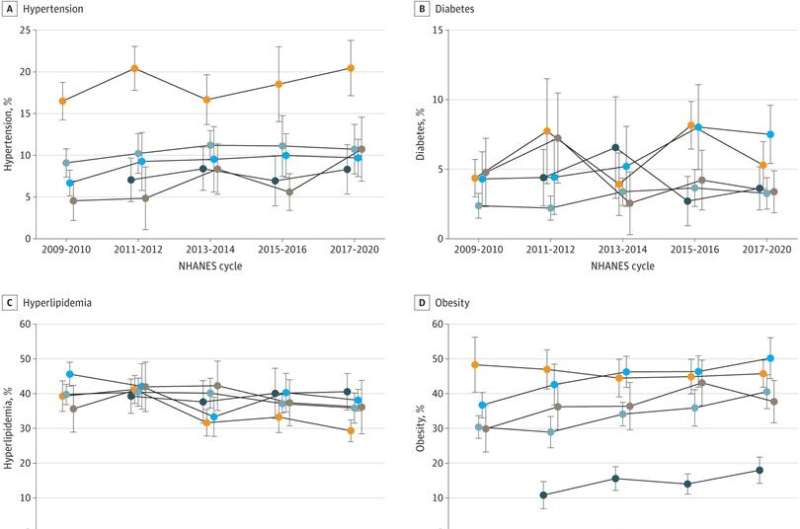This article has been reviewed according to Science X's editorial process and policies. Editors have highlighted the following attributes while ensuring the content's credibility:
fact-checked
peer-reviewed publication
trusted source
proofread
Sharp rise in cardiovascular risk factors among young adults may foreshadow public health crisis

In the United States, one person dies every 34 seconds from cardiovascular disease, making it the leading cause of death for men, women, and people of most racial and ethnic groups. While medical advances prompted steady declines in cardiovascular mortality throughout the second half of the 20th century, that progress has stalled over the past decade.
Public health experts have expressed concern that these trends may reflect worsening cardiovascular health among younger adults in their 20s, 30s and 40s. However, no study to date has comprehensively evaluated changes in the prevalence of cardiovascular risk factors among this group, nor have recent trends among younger adults been examined by race and ethnicity.
In a study published in JAMA and presented at the American College of Cardiology Scientific Sessions, researchers at Beth Israel Deaconess Medical Center (BIDMC) analyzed more than a decade's worth of data to examine rates of cardiovascular risk factors—such as high blood pressure, diabetes, obesity and smoking—among U.S. adults from 2009 to March 2020. They also looked at treatment rates for these risk factors and whether the treatments successfully controlled high blood pressure and elevated blood sugar.
The researchers observed a rise in hypertension and significant increases in diabetes and obesity rates among young adults, with no significant improvement in control of blood pressure or blood sugar. The scientists also observed substantial variation in these trends by race and ethnicity.
"The onset of cardiovascular risk factors early in life is associated with a higher risk of heart disease and acute events, such as heart attack and stroke, resulting in the substantial loss of quality of life and years of life," said corresponding author Rishi K. Wadhera, MD, MPP, MPhil, section head of Health Policy and Equity at the Smith Center for Outcomes Research in Cardiology at BIDMC. "Therefore, the substantial rise in the burden of cardiovascular risk factors among young adults will have major public health implications as the population ages."
This serial cross-sectional study included medical data and self-reported information from 12,924 young adults aged 20–44 who participated in the long-running National Health and Nutrition Examination Survey (NHANES) conducted by the Centers for Disease Control and Prevention. The group was 51% female, 57% white, 12% Mexican American, 8% other Hispanic, 13% Black and 10% other race and ethnicities.
Wadhera and colleagues observed that the prevalence of hypertension increased from 9% during 2009–2010 to 12% a decade later. Similarly, the researchers saw statistically significant increases in rates of diabetes, which climbed from three to four percent, and obesity, which rose from 33% to 41% during the study period. The percentage of young adults with a smoking history was high and did not change. In contrast, rates of high cholesterol declined from 41% in 2009–10 to 36% in 2017–20, a decrease the scientists suggest reflects government regulation of the use of trans fatty acids and other partially hydrogenated oils in packaged convenience foods and fast-food restaurants.
The researchers found substantial variation in prevalence of risk factors by race and ethnicity. Mexican Americans were the only group to experience a significant increase in diabetes. Obesity significantly increased across all racial and ethnic groups except Black adults. While rates of hypertension increased among Mexican Americans and other Hispanic adults, Black adults experienced the highest rates of hypertension.
"Hypertension prevalence in young Black adults was at least two times more likely than in all other racial and ethnic groups, with no improvement over the study period," said first-author Rahul Aggarwal, MD, a research fellow at the Smith Center and a cardiology fellow at Brigham and Women's Hospital.
"Black adults have high rates of stroke, heart failure and hypertensive renal disease, as well as the highest premature cardiovascular mortality rates in the country—in part due to a high burden of hypertension. These inequities are rooted in structural racism. Scalable and realistic solutions are needed—both community-based programs and large-scale health system initiatives that screen for and treat uncontrolled blood pressure in young Black adults, in combination with concerted policy efforts to address socioeconomic disparities."
The researchers also examined cardiovascular risk factor treatment and control rates among young adults. Treatment rates for hypertension did not significantly change during the study, with only approximately 55% of young adults with high blood pressure receiving treatment. However, among those receiving treatment, more than three-quarters of people achieved target blood pressure in 2017–20. Rates of diabetes treatment were also low, with one out of two young adults on therapy for their diabetes. Nearly half of young adults on treatment for diabetes had poor blood sugar control.
"The suboptimal treatment rates for high blood pressure and diabetes are concerning, and may be because many young adults aren't aware of their diagnosis," said Wadhera, who is also an assistant professor of medicine at Harvard Medical School. "The rise in cardiovascular risk factors that we observed could result in higher lifetime rates of heart attack, stroke, and heart failure, and have major public health implications over the long-term. Our findings should be a call-to-action to intensify public health and clinical interventions focused on the prevention and treatment of cardiovascular risk factors in young adults."
More information: Rahul Aggarwal et al, Cardiovascular Risk Factor Prevalence, Treatment, and Control in US Adults Aged 20 to 44 Years, 2009 to March 2020, JAMA (2023). DOI: 10.1001/jama.2023.2307




















